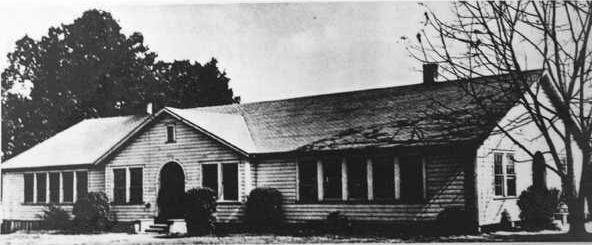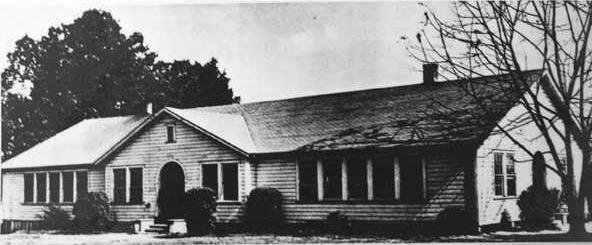Timeline
Pre-1880s (actual date unknown): Northwestern School, at the time a private school, opens
1880s: Public schools begin in church classrooms
1914: Beulah Rucker School begins
1936: Summer Hill High School damaged by tornado
1937: Fair Street School completed for grades 1 through 12
1950s: Hall County consolidates its schools; Fair Street School renovated; Northwestern re-opens to house overflow of students
1957-58: Fair Street wins state football championship
1962: Last class graduates from Fair Street High School; E.E. Butler High School opens
1963: Beulah Rucker Oliver dies
1969: E.E. Butler High School closes, merges with Gainesville High School
1970: First integrated class in city schools graduates
Coming Monday
A look back at Fair Street School as school officials and system leaders work to break ground on the new building.
Gainesville's black community is tight-knit, active and vibrant.
Its residents remember shows at Roxy Theater, mom-and-pop stores, doctors making house calls, and most of all, its schools.
Now the primary vestige of that is an empty brick building, patiently waiting for Jan. 26, when the old Fair Street School will be torn down to make way for new chapters in the history book.
"I look at Fair Street as being the centerpiece for the Newtown area. That's where blacks went," said Charles Morrow, a 1941 Fair Street High graduate and former history teacher and counselor.
"Fair Street was a place where they could come and feel welcome, recognizing the difficulties we had in getting certain kinds of things for our kids, but they also helped us establish the kinds of things we needed so the curriculum could be expanded."
Though Fair Street was the focal point in recent years, the school evolved from a rich history of education that began in the late 1800s, when the first private schools for black children were established.
The early days
Northwestern School was a private school started by the Northwestern Baptist Association under the leadership of Rev. Green Hunter, said Linda Hutchens, co-author of the Black America series book "Hall County Georgia."
"He was born a slave ... he managed to pull himself up by his bootstraps, put himself through a school in Atlanta and founded several churches around here. ... They worked and saved money and finally got enough where they constructed Northwestern School," she said. "One of the earliest school masters there was Professor Eugene Thompson."
Prior to actual public schools being built, black students attended class at one of two churches, either what is now St. Paul United Methodist or First Baptist on today's Martin Luther King Jr. Drive, Hutchens said.
The first public school built was Summer Hill High School, known on its degrees and documents as Gainesville Colored School. It wasn't until after the 1936 tornado that the original red brick building of Fair Street High School sprung up.
The Beulah Rucker School also made its mark on the map in the early 1900s when Beulah Rucker Oliver came to Gainesville with no money, yet determined to set up a school, Hutchens said.
Gainesville High 1987 graduate André Cheek's fondest memory of writing her play on black history was interviewing Rucker before she died in 1963. Rucker went to school in the early 1900s, when high school went only to 11th grade. To graduate a senior, she had to go to Atlanta to finish her final year.
According to a 1994 story in The Times, the school was twofold, housing the Industrial High School and Timber Ridge Elementary School. The school operated through the 1950s as an elementary school that some students attended before they went to Fair Street.
After the tornado
The original Fair Street School building was built in 1937 to replace the damaged Summer Hill High.
When Hall County consolidated its schools in the 1950s, black students from Lula, Mount Zion, Cross Trains and others areas were bused to Fair Street. Lumpkin County students were sent, too.
"Needless to say that could not hold all of those students so an addition had to be built. Fair Street was so crowded that the city of Gainesville had to lease the old Northwestern School. It had ceased being a private school by that time and it was abandoned," Hutchens said.
Jerry Castleberry, transportation director for Gainesville City Schools, attended Northwestern starting in first grade. For a few years, the school had students coming in shifts.
"If you lived north of Myrtle Street, you went during the morning session, and if you live south of Myrtle Street, you went to the afternoon class," he said.
After several grades at Northwestern, students moved up to Fair Street. The high school portion was separated in the 1960s when E.E. Butler High School was built, named for the black community's beloved local doctor.
"My understanding is Dr. (E.E.) Butler was not from Gainesville, but did move to the Gainesville area and in his honor, the mascot for Fair Street derived as a tiger because he was a graduate of Morehouse College," Cheek said.
When Gainesville City Councilwoman Myrtle Figueras taught French at Butler High in 1965 most of the teachers weren't older than 30.
"We had a great time together as friends and as educators. The students had so much of a sense of pride in where they were," she said. "Because of the pride young people had in school, they seemed to just want to do the work because the teacher said, ‘Do it.'"
In those days, the city children weren't bused to school.
"They had to walk to school in the cold, when it snowed, and when they got there, there would be varying levels of students in the classroom," Cheek said. "They would have to use worn and torn books donated from other schools and those often had ripped pages."
Castleberry said at the time, most black students didn't know they were losing out. They had a good education and that was what mattered.
"We had a principal, Mr. Ulysses Byas, who was ahead of his time when it came to promoting and getting us out there and doing whatever it took to make sure we had courses that we would need to move us forward," Hutchens said. "It may not have had the latest textbooks or the science labs might not have been as equipped as Gainesville High School, but our teachers filled in the gaps."
Ella Jean Smith, co-author of the Black America series book "Hall County Georgia," remembers Butler having a white student and a white teacher, but the same wasn't true at Gainesville High until after integration.
"I can remember being in the fifth grade and my teacher said one day we would be in a classroom with whites and we would sit at the table with them," she said. "Being 10 years old I thought to myself, ‘That's hard to believe.'"
Integration and beyond
In 1969, however, the "hard to believe" became reality as Gainesville City Schools System merged its two high schools under the Gainesville High roof, though Butler High being the newer facility.
"The black children were very devastated because they did not want to move," said Figueras, who was able to maintain her position. "Hall County at that time took their students back from the city ... and left Butler with too few students to leave the school open. ... I cried, yes, but at the same time, I understood."
City officials tried to ease the effects of the consolidation, but black faculty weren't permitted to work in some of the areas they were more qualified in than the white teachers, Morrow said.
"I couldn't get the job I wanted. They wanted to put me as a middle school counselor and I refused to accept it on the basis of I was the most qualified person in that particular area," he said. "They chose to put another person in there (as counselor) who didn't even have a degree in counseling. I was told that either I accept that position that was assigned to me or I could leave. I chose to leave."
Castleberry, who graduated before integration, remembers the lack of Butler High teachers as a point of contention. The football team, for example, won two state championships, yet there was no room for Butler High's head coach at Gainesville High.
An Aug. 22, 1969, story from The Times chronicles the preparation for integration at Gainesville High.
"We don't plan a lot of fanfare in this ... there have never been any restrictions about who could participate in activities. Certainly there won't be any now," then-Principal Curtis Segars said.
Gainesville High reportedly also sent letters to former Butler High band members and football players, extending the invitation to join the Red Elephants' squads.
School pride changed after integration.
"The young people felt as though they had lost their home," Figueras said. "Many of the children were placed in lower-level classes and they were not placed where they could reach their potential. It was like there wasn't enough expectation."
Morrow sees the culture of black education changing somewhat, where black students are more accepted in most fields. He feels there still is resistance, however, in academia.
"It's OK if you can play good football or are a good athlete, but they don't want strong competition of blacks for the academic areas," he said. "There's never been a black person in the city of Gainesville that has been the valedictorian."
Now there's another kind of integration going on: merging the past with the present under the roof of the new Fair Street International Baccalaureate World School, set to be completed in December 2013.
"The community will know exactly how the south side of Gainesville will be integrated into the school," Figueras said. "We're seeing it as a new school, yes, but an extension of the past."

